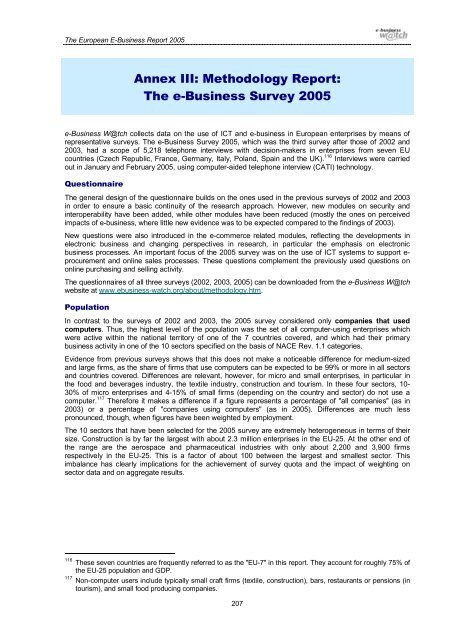The European e-Business Report The European e ... - empirica
The European e-Business Report The European e ... - empirica
The European e-Business Report The European e ... - empirica
You also want an ePaper? Increase the reach of your titles
YUMPU automatically turns print PDFs into web optimized ePapers that Google loves.
<strong>The</strong> <strong>European</strong> E-<strong>Business</strong> <strong>Report</strong> 2005<br />
Annex III: Methodology <strong>Report</strong>:<br />
<strong>The</strong> e-<strong>Business</strong> Survey 2005<br />
e-<strong>Business</strong> W@tch collects data on the use of ICT and e-business in <strong>European</strong> enterprises by means of<br />
representative surveys. <strong>The</strong> e-<strong>Business</strong> Survey 2005, which was the third survey after those of 2002 and<br />
2003, had a scope of 5,218 telephone interviews with decision-makers in enterprises from seven EU<br />
countries (Czech Republic, France, Germany, Italy, Poland, Spain and the UK). 116 Interviews were carried<br />
out in January and February 2005, using computer-aided telephone interview (CATI) technology.<br />
Questionnaire<br />
<strong>The</strong> general design of the questionnaire builds on the ones used in the previous surveys of 2002 and 2003<br />
in order to ensure a basic continuity of the research approach. However, new modules on security and<br />
interoperability have been added, while other modules have been reduced (mostly the ones on perceived<br />
impacts of e-business, where little new evidence was to be expected compared to the findings of 2003).<br />
New questions were also introduced in the e-commerce related modules, reflecting the developments in<br />
electronic business and changing perspectives in research, in particular the emphasis on electronic<br />
business processes. An important focus of the 2005 survey was on the use of ICT systems to support e-<br />
procurement and online sales processes. <strong>The</strong>se questions complement the previously used questions on<br />
online purchasing and selling activity.<br />
<strong>The</strong> questionnaires of all three surveys (2002, 2003, 2005) can be downloaded from the e-<strong>Business</strong> W@tch<br />
website at www.ebusiness-watch.org/about/methodology.htm.<br />
Population<br />
In contrast to the surveys of 2002 and 2003, the 2005 survey considered only companies that used<br />
computers. Thus, the highest level of the population was the set of all computer-using enterprises which<br />
were active within the national territory of one of the 7 countries covered, and which had their primary<br />
business activity in one of the 10 sectors specified on the basis of NACE Rev. 1.1 categories.<br />
Evidence from previous surveys shows that this does not make a noticeable difference for medium-sized<br />
and large firms, as the share of firms that use computers can be expected to be 99% or more in all sectors<br />
and countries covered. Differences are relevant, however, for micro and small enterprises, in particular in<br />
the food and beverages industry, the textile industry, construction and tourism. In these four sectors, 10-<br />
30% of micro enterprises and 4-15% of small firms (depending on the country and sector) do not use a<br />
computer. 117 <strong>The</strong>refore it makes a difference if a figure represents a percentage of "all companies" (as in<br />
2003) or a percentage of "companies using computers" (as in 2005). Differences are much less<br />
pronounced, though, when figures have been weighted by employment.<br />
<strong>The</strong> 10 sectors that have been selected for the 2005 survey are extremely heterogeneous in terms of their<br />
size. Construction is by far the largest with about 2.3 million enterprises in the EU-25. At the other end of<br />
the range are the aerospace and pharmaceutical industries with only about 2,200 and 3,900 firms<br />
respectively in the EU-25. This is a factor of about 100 between the largest and smallest sector. This<br />
imbalance has clearly implications for the achievement of survey quota and the impact of weighting on<br />
sector data and on aggregate results.<br />
116 <strong>The</strong>se seven countries are frequently referred to as the "EU-7" in this report. <strong>The</strong>y account for roughly 75% of<br />
the EU-25 population and GDP.<br />
117 Non-computer users include typically small craft firms (textile, construction), bars, restaurants or pensions (in<br />
tourism), and small food producing companies.<br />
207

















